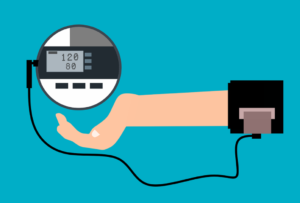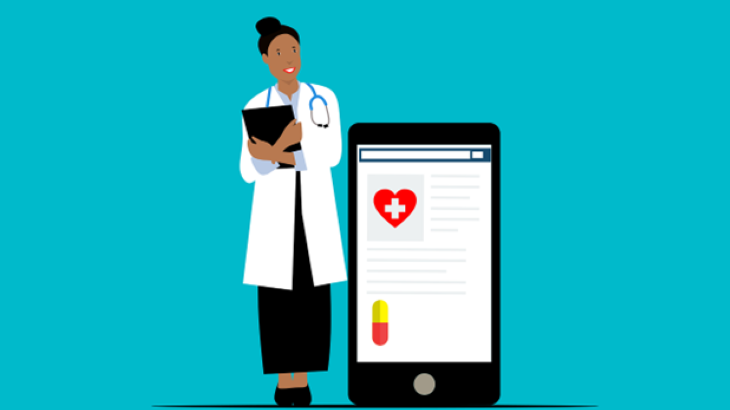By Jaspreet Sanghera, Biology & Life Sciences editor
Since the start of the COVID-19 pandemic, virtual connection has become a routine part of our work and personal lives. This phenomenon extends to healthcare, too. In February 2020, 48% of Canadian physicians incorporated at least one virtual care service into their practice, but by September 2020, that figure increased to 83%. In that same period, the proportion of patients receiving a virtual care service also rose, jumping from 6% to 56% .
Virtual care encompasses all the ways healthcare providers virtually or remotely interact with patients. This includes telephone calls, private messaging, and video conferencing. One specific form of virtual care is remote automated monitoring. Remote monitoring is being explored as a potential way to connect healthcare workers with patients at home.
You may already be familiar with personal health monitoring devices. Most smart watches or healthcare wearables, such as a FitBit, have sensors to help you quantify and monitor health markers like your daily step count, distance walked, calories burned, heart rate, or sleep cycle. This data is displayed in easy-to-read apps for personal use.
Similarly, remote monitoring involves monitoring the patient’s health markers and responding promptly as and when needed. An example of a remote automated monitoring device is a tablet that is provided to patients along with a take-home kit with a weight scale and measurement devices that can measure health markers such as heart rate, blood pressure, respiratory rate, oxygen saturation, temperature, and body weight. Patients take their own measurements daily, photograph healing wounds, and videoconference with their healthcare team for regular check-ins without needing to travel to a clinic or hospital. Thus, healthcare workers can monitor for red flags, make treatment changes, and expand their reach to geographically remote areas.
Although this technology is not yet widely used, research is being done to ascertain the feasibility and effectiveness of this approach.
Remote monitoring for post-surgical patients

In remote monitoring, patients are provided with monitoring equipment to take home and trained to use it. Image by Mohamed Hassan from Pixabay.
In a recent study at McMaster University, Dr. Philip Devereaux and his collaborators examined the use of remote automated monitoring technology in 451 patients who underwent non-elective surgery at eight Canadian hospitals. Each patient was provided with and trained to use a tablet device and other necessary equipment such as blood pressure cuffs and heart rate monitors. The goal was to assess the impact of remote monitoring on these patients in the 31 days following their surgeries, compared with a group that received the standard model of care in which patients must go see their doctor for follow-up concerns. Patients in the remote monitoring group provided daily measurements of their vital signs and engaged in regular check-ins with nurses. CloudDX, a digital healthcare company founded in Kitchener, Ontario, created the technology used in the study.
The researchers found that 30% of participants in the virtual group had a drug error detected and corrected compared with the 6% in the standard care group. The most common error was drug omission by patients, either intentionally or mistakenly. Ease of connection allowed nurses to perform regular drug reconciliations and to reinforce the patient’s recovery plan with them.
Fewer people in the remote monitoring group reported pain at 7, 15, and 30 days after surgery. Researchers suggest that through regular virtual care, healthcare providers were able to respond to patients’ reported pain more readily (such as with appropriate adjustments to pain medication) than in the standard model of care.
Finally, researchers found that virtual care and remote monitoring reduced the risk of acute hospital care and emergency room visits. Patient’s concerns could be responded to promptly without resorting to visiting an emergency room. This finding is notable as hospitals continue to cope with the effects of COVID-19. There is a need to reduce the use of acute hospital care to maintain hospital capacity and to facilitate the management of the backlog of elective surgeries.
This study tentatively suggests the acceptability of virtual care and remote monitoring by both patients and physicians. It also suggests the potential to save patients time, money, and energy from traveling to clinics and the potential to reserve hospital space for new patients.
Connecting to patients all over Canada
Ideally, this technology could have a huge impact in rural communities that do not have sufficient access to healthcare resources. In fact, in northern Ontario, indigenous and rural patients with lung, heart, and other chronic conditions are benefitting from a remote monitoring pilot program initiated as part of the province’s pandemic response.
It is important to note that one key barrier to virtual care is insufficient internet connectivity in rural regions. Canada recognized the importance of rural connectivity for public health and other functions and has set up a Universal Broadband Fund to begin investing in enhanced digital infrastructure in these regions.
Further, patients with cognitive impairments or neurodegenerative diseases may not be able to engage in remote monitoring without assistance. In their cases, wearable sensors are a feasible alternative to a tablet device.
But what do patients and doctors think about this shift towards virtual care?
Attitudes towards virtual care and remote monitoring are shifting.
In this study, most patients agreed to remote monitoring. Out of a total of 3211 eligible patients, 18% chose not to participate. For another 18% of patients, their surgeons did not agree to them participating.
In heart failure patients, one survey found that patients and clinicians were willing to use a remote monitoring system as long as several conditions were met, including provision of easy-to-use system with clear tangible benefits, maintaining good patient–provider communication, and no increase in clinical workload.
Virtual care and related technologies are evolving rapidly. Healthcare is not just about treating a patient’s symptoms. It involves building and maintaining trusting connections between healthcare providers and patients. Remote monitoring, and virtual care more broadly, give healthcare workers another tool to build these key connections with the populations they serve.
Featured image: Virtual care is rapidly evolving as more physicians and patients deliver and receive this form of healthcare. Image by Mohamed Hassan from Pixabay.




